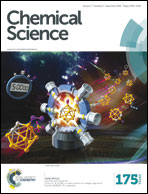Dithieno[3,2-b:2′,3′-d]pyridin-5(4H)-one based D–A type copolymers with wide bandgaps of up to 2.05 eV to achieve solar cell efficiencies of up to 7.33%†
Abstract
Two new polymers, PDTPO-IDT and PDTPO-IDTT, are synthesized through copolymerization of 4-(2-octyldodecyl)-dithieno[3,2-b:2′,3′-d]pyridin-5(4H)-one (DTPO) with indacenodithiophene (IDT) or indacenodithieno[3,2-b]thiophene (IDTT). The rational combination of the planar DTPO unit with ladder-type IDT and IDTT units endows the resulting copolymers with wide optical bandgaps of ca. 2.05 eV, low HOMO energy levels of ca. −5.32 eV and good hole-transporting abilities with a hole mobility of 1.0 × 10−3 cm2 V−1 s−1. The polymer solar cell (PSC) in a conventional structure based on PDTPO-IDT as donor and [6,6]-phenyl-C71-butyric acid methyl ester (PC71BM) as acceptor achieves a high power conversion efficiency (PCE) of up to 7.33%, the highest value for PSCs based on polymers with optical bandgap over 2.0 eV to date, along with a remarkable open-circuit voltage (Voc) approaching 0.97 V. The performance of the PDTPO-IDTT based PSC is slightly behind this with a moderate PCE of 5.47% under the same conditions. The relationship between the copolymer structures and optoelectronic properties as well as photovoltaic performance are comprehensively investigated by experiments and theoretical simulations.
![Graphical abstract: Dithieno[3,2-b:2′,3′-d]pyridin-5(4H)-one based D–A type copolymers with wide bandgaps of up to 2.05 eV to achieve solar cell efficiencies of up to 7.33%](/en/Image/Get?imageInfo.ImageType=GA&imageInfo.ImageIdentifier.ManuscriptID=C6SC01791F&imageInfo.ImageIdentifier.Year=2016)
- This article is part of the themed collections: Global Energy Challenges: Solar Energy and Global Energy Challenges: Energy Applications

 Please wait while we load your content...
Please wait while we load your content...